Day trips from Dubai to Oman offer an intriguing option for those looking to explore beyond the urban splendor of Dubai and delve into the diverse landscapes and rich cultural heritage of its neighboring country, Oman. Situated just a short drive away, Oman serves as a perfect getaway, presenting a contrast to Dubai’s futuristic skyline with its rugged mountains, historic forts, and tranquil desert expanses.
A journey from Dubai to the northern regions of Oman can start with a visit to the enclave of Musandam. Known for its spectacular fjord-like khors, carved by the waters of the Gulf of Oman, Musandam is a haven for nature lovers and adventure seekers. Activities such as dhow cruises offer serene views of the dramatic coastline and opportunities for dolphin watching, providing a peaceful retreat from the bustling city life of Dubai.
Further exploration into Oman can lead visitors to the city of Sohar, historically reputed as the birthplace of the legendary sailor Sinbad. This coastal city combines its rich maritime history with modern attractions. The Sohar Fort, a large museum housed within an ancient fortification, tells tales of Oman’s storied past, while the nearby beaches offer a chance to relax along the scenic shores of the Gulf of Oman.

Dubai
Culturally, Oman and Dubai share many similarities, but each has its own unique characteristics shaped by their histories and landscapes. Omani cuisine, with its distinctive use of spices and flavors, provides a delightful culinary adventure for visitors. Sampling traditional dishes such as shuwa, marinated lamb slow-cooked in an underground sand oven, can be a highlight of the visit.

Oman
Day trips from Dubai to Oman not only cater to those seeking picturesque landscapes and cultural experiences but also to history enthusiasts. The ancient city of Nizwa, located a bit farther from the border, is home to one of the oldest forts in Oman, dating back to the 17th century. Nizwa offers a look into Oman’s Islamic architecture and its historical trade routes that once served as a nexus for the exchange of goods and ideas across the Arabian Peninsula.
Each of these destinations within Oman provides a glimpse into the country’s rich heritage and natural beauty, making them ideal for those looking to enrich their understanding of the region. The ease of travel between Dubai and these Omani locales makes them accessible for short visits, yet each trip promises a full and enriching experience that contrasts with and complements the city life of Dubai.
Explore Musandam Peninsula’s Fjords
The Musandam Peninsula, a rugged and scenic extension of Oman’s territory, just boldly into the Strait of Hormuz, separating the Persian Gulf from the Gulf of Oman. This region is revered for its dramatic landscape, which closely resembles the storied fjords of Norway, earning it the moniker “Norway of Arabia.” The similarity lies in the steep, rocky cliffs that rise majestically from the emerald waters, creating a network of natural coves and inlets that are a visual spectacle unlike any other in the Arabian Peninsula.
Visitors to the Musandam Peninsula are greeted with an array of natural wonders. The fjord-like inlets, locally known as ‘khors,’ offer serene and stunning views of the sea intertwined with rugged mountain scenery. The area’s unique geography makes it a favorite spot for those looking to escape the hustle and bustle of city life and immerse themselves in nature. Dhow cruises, traditional Omani wooden boats, are a popular way to explore these inlets. These cruises provide an intimate experience of the area’s natural beauty, often including stops at isolated fishing villages and opportunities for snorkeling and swimming in the clear waters, where the marine life is as vibrant as the landscapes above.

Musandam Peninsula
Day trips from Dubai to Musandam are a convenient option for those looking to experience a different landscape and culture without the need for extensive travel. These trips usually involve a scenic drive along the coast of the Gulf of Oman, leading to the entry into Omani territory where the adventure begins. The journey itself is part of the experience, with changing landscapes that preview the dramatic shifts in topography that Musandam has to offer.
Upon arriving in Musandam, the dramatic shift from the desert landscapes of the Emirates to the maritime and mountainous vistas of Oman is striking. The waters around the peninsula are renowned for their clarity and tranquility, making them ideal for marine activities like diving and snorkeling. These activities not only provide relaxation and enjoyment but also an appreciation for the rich biodiversity of the region.
The Musandam Peninsula also offers more than just sea-based activities. The rugged mountains are ideal for hiking and provide panoramic views of the surrounding area, including the vast expanse of the Gulf of Oman. The cooler climate in the mountains offers a refreshing break from the heat of the lower lands, making it a perfect spot for picnics and scenic photography.
Discover the Charm of Nizwa
Nizwa, once the capital of Oman during the 6th and 7th centuries, remains a vital and enchanting city, rich with history and culture. Positioned at the base of the Al Hajar Mountains in Oman, this city provides a tangible connection to the past through its well-preserved architecture, bustling souk, and historically significant landmarks.
One cannot discuss Nizwa without acknowledging its profound historical significance. As a former capital, it was a strategic epicenter for the dynastic politics of the region and played a critical role in the spread of Islam throughout Oman. This rich history is palpable as you wander through the city, with its ancient buildings offering a window into a storied past.
Central to Nizwa’s daily life and a key attraction is its souk, an authentic market that has operated for centuries. This market is more than a place for transactions; it serves as a cultural hub where locals and tourists alike can immerse themselves in the traditional Omani way of life. Visitors can explore stalls filled with handicrafts, silver jewelry, Omani sweets, and intricately hand-carved khanjars (traditional daggers). The souk is also renowned for its Friday cattle market, where the age-old practices of bartering and trading give a glimpse into the traditional agrarian lifestyle that still thrives in rural Oman.
Among Nizwa’s architectural marvels, Nizwa Fort stands out prominently. Built in the 1650s by Imam Sultan Bin Saif Al Ya’rubi, it is a testament to the ingenuity of Omani engineering. The fort’s massive circular tower, which dominates the city’s skyline, was designed to withstand lengthy sieges and is equipped with numerous defensive features such as honey-trapped entrance doors and strategically placed shooting windows. Inside, the fort houses a museum that displays artifacts from the area, providing insights into the military, social, and economic aspects of Middle Eastern life in earlier centuries.

Nizwa
Another iconic landmark near Nizwa is Al Hoota Cave, located approximately 40 kilometers from the city. This natural wonder, accessible to the public, offers an extraordinary journey into the underground world of stalactites and stalagmites formed over millions of years. The cave system extends over 4.5 kilometers, but only a portion is accessible for tours. The presence of a rare species of blind fish, known as Garra barreimiae, which thrives in the cave’s ecosystem, adds a unique biological significance to the site.
Adventure in Jebel Jais
Jebel Jais, the tallest mountain in the United Arab Emirates, located in Ras Al Khaimah, offers a playground for adventure enthusiasts and nature lovers alike. This spectacular destination draws visitors with its unique blend of natural beauty and exhilarating activities, anchored by the world’s longest zipline—a must-try for thrill-seekers.
The Jebel Jais Flight is the star attraction, holding the Guinness World Record for the longest zipline on the planet. This adrenaline-pumping experience allows participants to soar across jagged mountain landscapes at speeds of up to 150 kilometers per hour, covering a distance of nearly 3 kilometers. The zipline starts from a platform situated at a breathtaking 1,680 meters above sea level, offering unparalleled views of the Hajar Mountains’ craggy peaks and the vivid blue sky. The thrill of speeding down the slope, with the wind in your face and the ground far below, is an unforgettable experience, providing both exhilaration and a unique perspective on the region’s dramatic natural beauty.
Aside from the physical activities, Jebel Jais is equipped with visitor facilities that enhance the experience. These include viewing decks that provide spectacular panoramic views and picnic areas where families and friends can relax after a day of adventure.
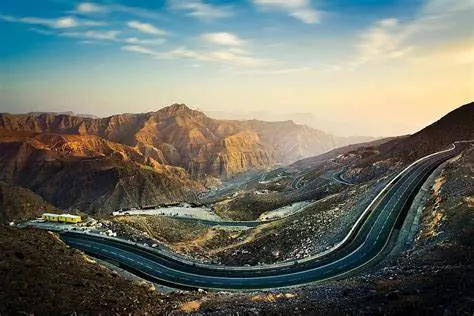
Jebel Jais
For residents and tourists based in Dubai, Jebel Jais offers a refreshing escape from the city’s bustling environment. The mountain is accessible by a well-maintained road that snakes its way up the slopes, making it a convenient day trip. The drive itself is part of the adventure, with each turn revealing more of the area’s stunning natural beauty. Those looking for an extended excursion might consider a multi-day trip that could include visits to nearby attractions in Ras Al Khaimah or even across the border into Oman. The proximity to Oman makes it feasible to plan a cross-border trip, combining the rugged mountains of Jebel Jais with the serene beaches and rich cultural heritage of Oman, though this requires additional planning and travel time.
Jebel Jais thus stands as a beacon of adventure tourism in the UAE, attracting visitors with its blend of natural splendor and thrilling activities. It’s a place where the adventures are as high as the peaks and as broad as the horizons, inviting all who dare to explore and enjoy.
Cultural Journey to Al Ain
Al Ain, often referred to as the Garden City due to its lush greenery, stands as a stark contrast to the sandy dunes typically associated with the UAE. This city offers a profound cultural journey through its historic sites and museums, making it an ideal destination for those looking to delve into the rich heritage of the region.
One of the city’s most significant cultural treasures is the Al Ain Oasis. This sprawling oasis is a living museum, showcasing traditional falaj irrigation systems that have been used for centuries to support the agriculture in the area. The sight of palm groves and working farms within the oasis provides a unique glimpse into the ingenious agricultural practices of the past, which have sustained communities in this harsh desert environment. Walking through the shaded walkways lined with over 147,000 date palms, visitors can appreciate the balance between cultural tradition and nature that Al Ain has mastered.
Another cornerstone of Al Ain’s cultural landscape is the Al Ain Museum. Located next to the historic Al Ain Fort, it is the oldest museum in the UAE and offers insight into the country’s anthropological and ethnographical history. The museum houses a diverse collection of artifacts that span the ages, from ancient pottery and jewelry found in the region to weaponry and tools used by the local tribes. The adjoining fort also provides a backdrop for understanding the military history of the UAE, showing how the region’s leaders defended their territories against invasions and maintained peace among tribes.
Further enriching Al Ain’s cultural offerings are its UNESCO-listed sites, which include Hafit, Hili, Bidaa Bint Saud, and the oases areas. These sites are pivotal in understanding the human occupation patterns in this part of the world, dating back to the Neolithic period. The archaeological findings at these sites illustrate early agricultural practices, the beginnings of bronze metallurgy, and the evolution of social practices. For visitors, these sites are not just educational experiences but are portals back in time, offering a chance to walk through the very landscapes where early inhabitants once roamed.
While Al Ain itself is steeped in cultural heritage, its location also offers possibilities for broader explorations. For instance, day trips from Dubai to neighboring regions like Oman can complement the cultural journey in Al Ain. These trips allow visitors to compare and contrast the preserved historical elements of Al Ain with the vibrant, contemporary cultures of Dubai and the scenic landscapes of Oman, providing a broader context to the heritage and cultural dynamics of the Arabian Peninsula.
Visiting Al Ain is a journey through time and tradition, offering deep insights into the ways the past has shaped the present in this part of the world. Each site in Al Ain tells a story of survival, innovation, and tradition, woven into the fabric of the UAE’s cultural identity. This city provides not just a break from the bustling city life of its urban counterparts but also a rich, educational experience that leaves visitors with a profound appreciation for the region’s history and its people’s resilience.
Wildlife and Nature at Al Ain Zoo
Al Ain Zoo stands as a premier destination for wildlife and nature enthusiasts, offering a blend of education, conservation, and recreation. Established in 1968 by the late Sheikh Zayed bin Sultan Al Nahyan, the zoo spans over 900 hectares on the foothills of the Jebel Hafeet Mountains, making it one of the largest zoos in the Middle East. It provides an inviting setting for family outings and is acclaimed for its commitment to the conservation of endangered species.
The zoo houses over 4,000 animals, with approximately 30% of its species classified as endangered. This extensive collection allows visitors to encounter a diverse range of wildlife in environments that closely mimic their natural habitats. One of the zoo’s significant attractions is the African Safari, where guests can embark on a guided tour across a 217-hectare area designed to replicate the African savannah. Here, families can observe lions, zebras, giraffes, and rhinoceroses roaming freely, offering a unique opportunity to view these majestic animals up close in a setting that respects their natural lifestyles.
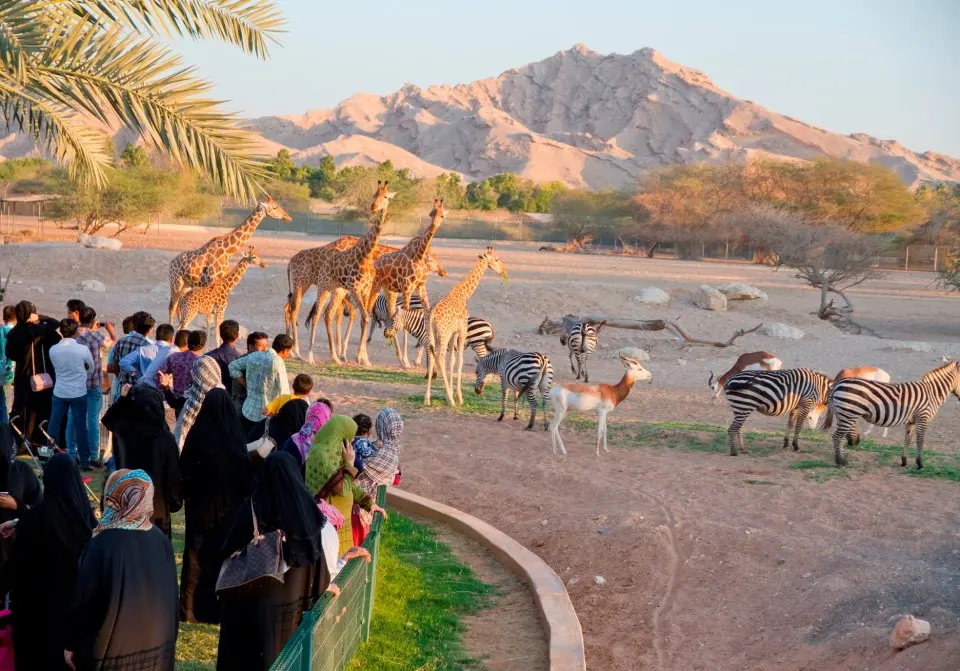
Al Ain Zoo
Children and adults alike can benefit from the educational programs offered by Al Ain Zoo. These programs aim to raise awareness about wildlife conservation through interactive workshops and guided tours. These initiatives teach visitors about the ecological roles of different species and the importance of biodiversity preservation.
In addition to its wildlife attractions, Al Ain Zoo emphasizes visitor engagement through various family-friendly activities. The petting zoo is especially popular among younger visitors, offering them the chance to interact with domestic animals like goats, sheep, and ponies under careful supervision. This hands-on approach helps foster a connection between young minds and the principles of animal care and respect.
Al Ain Zoo also features a reptile house, which is home to various species of snakes, lizards, and crocodiles. This section of the zoo provides a comprehensive look at these often misunderstood creatures, dispelling myths and instilling a sense of wonder about their unique adaptations and survival strategies.
The commitment of Al Ain Zoo to conservation is evident not only in its public displays and educational efforts but also in its behind-the-scenes conservation projects. These include breeding programs for endangered species, such as the Arabian oryx and the African wild dog, aimed at reintroducing these animals into their natural habitats.
Overall, Al Ain Zoo offers a comprehensive and engaging experience that blends the enjoyment of seeing exotic animals with the deeper understanding of environmental conservation challenges. It stands out not only as a fun day out for families but as a crucial educational tool in the global fight to preserve wildlife and their natural environments.
Muscat’s Architectural Wonders
Muscat, the capital of Oman, offers a fascinating blend of ancient and modern architecture that captivates visitors.
One of the highlights of any visit to Muscat is the Grand Mosque, officially known as the Sultan Qaboos Grand Mosque. This architectural marvel is not only a site of religious significance but also a masterpiece of modern Islamic architecture. The mosque’s grand scale and exquisite detail can occupy much of your visit. It accommodates 20,000 worshippers and features a blend of Islamic, Middle Eastern, and Omani architectural styles. The main prayer hall boasts a breathtaking 70-meter high dome and is home to one of the world’s largest hand-woven carpets and a spectacular chandelier. The use of Indian sandstone and the intricate woodwork add to its aesthetic and spiritual allure.
In addition to the Grand Mosque, the Royal Opera House Muscat provides another example of the exquisite modern architecture that the city has to offer. As the leading arts and culture venue in Oman, the Opera House reflects contemporary Omani craftsmanship. Its marble-clad facade and modern Islamic architectural elements make it a focal point in Muscat’s cultural landscape. Visitors can explore the premises or even catch a performance, which ranges from opera to Arab music concerts, enhancing the cultural experience of the trip.
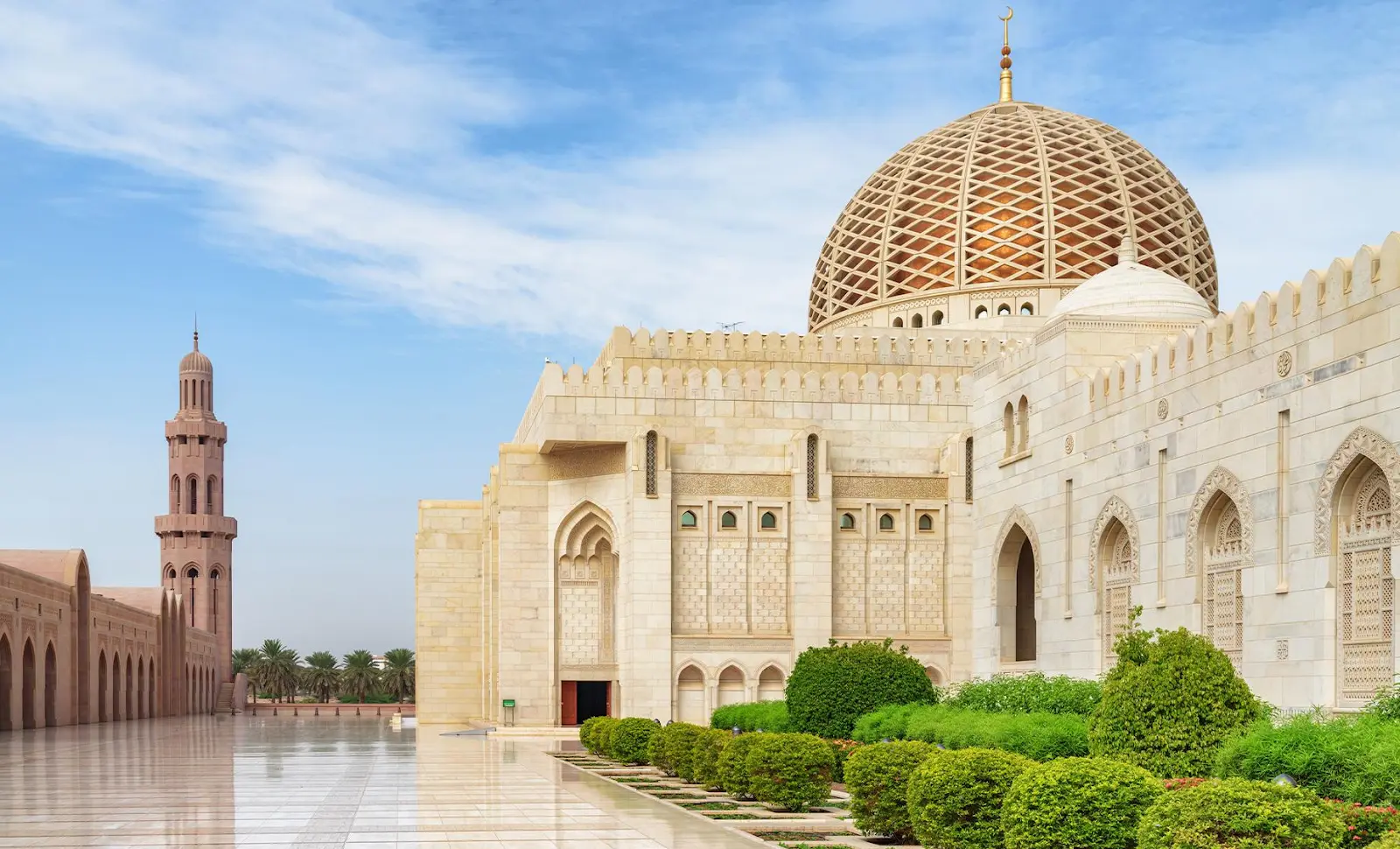
Muscat
No visit to Muscat would be complete without a stroll through one of its vibrant souks. Muttrah Souk, located by the sea, is one of the oldest marketplaces in the Arab world. Here, visitors can immerse themselves in a bustling atmosphere where the scents of frankincense and Arabic perfumes fill the air. The souk is a maze of alleyways lined with shops selling a variety of traditional Omani and Bedouin handicrafts, textiles, and jewelry. Shopping in the souk not only offers a chance to pick up unique souvenirs but also provides a glimpse into the daily life and the commercial history of the region.
Another architectural site worth visiting is Al Jalali and Al Mirani forts, perched on rocky hills on either side of the old town. These forts date back to the Portuguese occupation in the 16th century and offer insight into Muscat’s strategic maritime importance and its historical defense mechanisms. While access to the interiors of the forts is restricted, the surrounding areas provide excellent vantage points for panoramic views of Muscat’s port and landscape.
For nature enthusiasts, a short drive from the city center will lead to the Qurum Beach and the Qurum Nature Reserve. This area offers a pleasant escape with its lush parkland, spreading along the coast, and is ideal for a relaxing end to a day of architectural and cultural exploration.
A day trip from Dubai to Muscat is a journey through time, where the grandeur of modern achievements in architecture meets the charm and tradition of ancient structures. Each site in Muscat tells a story, contributing to a deeper understanding of the Gulf’s rich cultural fabric and architectural heritage.
Snorkeling and Swimming in Khasab
Khasab, located in the Musandam Peninsula of Oman, is a gem of natural beauty and marine allure. This coastal city, often referred to as the “Norway of Arabia,” offers an unforgettable experience for snorkeling and swimming enthusiasts. Its unique geographical features, with dramatic fjords and crystal-clear waters, create an ideal environment for marine exploration. Among the most famous spots for these activities is Telegraph Island, where the remnants of British colonial history merge with vibrant underwater ecosystems.
Snorkeling around Telegraph Island is a highlight for visitors. The waters here are teeming with marine life, offering a spectacular display of colorful coral reefs and an array of exotic fish species. The island, originally a strategic telegraph station in the 19th century, now provides a silent backdrop to the vivid underwater life. Snorkelers often encounter schools of angelfish, parrotfish, and sometimes even dolphins. The clear waters provide excellent visibility, enhancing the overall experience of exploring the aquatic world.
Swimming in the fjords of Khasab offers a refreshing escape from the heat. The serene and sheltered waters of the fjords make swimming safe and enjoyable for all age groups. The calm bays and inlets are perfect for a leisurely swim, allowing one to soak in the panoramic views of the rugged mountains that rise dramatically from the fjords. This natural scenery forms a stark contrast to the peaceful aquatic environment, making the swimming experience in Khasab truly unique.
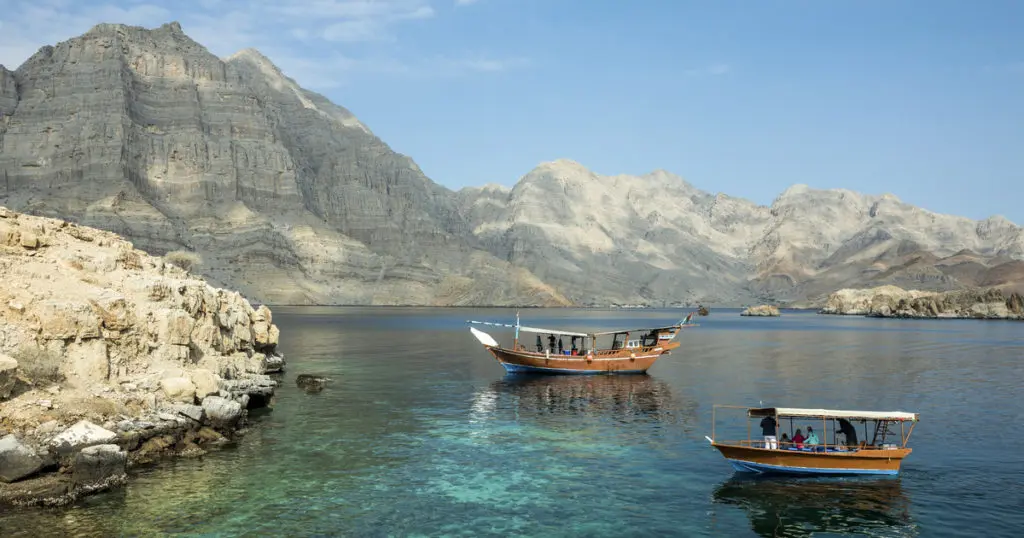
Khasab
Moreover, Khasab’s waters are ideal for more than just snorkeling and swimming. Kayaking and scuba diving are also popular activities that attract tourists. Kayaking through the fjords allows for a closer and more personal interaction with the environment. Paddling through the calm waters, visitors can explore hidden coves and secluded beaches at their own pace. For the more adventurous, scuba diving trips offer deeper explorations of the marine life that thrives beneath the surface. Experienced divers can dive around Telegraph Island and other nearby sites, where they are often greeted by larger marine species and enchanting underwater landscapes.
Beach Camping in Khasab
Beach camping in Khasab offers a refreshing escape into the tranquil beauty of nature. Khasab, a port city on the northern tip of Oman’s Musandam Peninsula, is renowned for its rugged mountains and clear waters, making it a prime destination for those looking to combine adventure with relaxation. Here, the allure of camping right on the beach captivates travelers seeking a unique way to experience the serene landscapes of the Gulf.
Khasab’s beaches are picturesque, with golden sands meeting the vibrant blue of the sea. The area’s relative seclusion contributes to a sense of peace and privacy that is hard to find in more bustling tourist spots. As the sun sets, the sky turns into a canvas of oranges and pinks, offering campers a spectacular view that enhances the camping experience.
Once in Khasab, the options for beach camping are plentiful. Campers can choose from several spots along the coastline where they can set up their tents. These locations offer not only stunning views but also opportunities to engage in a variety of water sports such as snorkeling, diving, and kayaking. The clear waters of Khasab are home to a diverse range of marine life, providing an excellent backdrop for underwater exploration.
One of the highlights of camping in Khasab is the chance to witness dolphins. The waters around the Musandam Peninsula are known for their dolphin populations, and many campers are thrilled to see these playful creatures frolicking in the sea.
As night falls, beach camping in Khasab transforms into an even more magical experience. The lack of light pollution allows for spectacular stargazing. Lying on the beach under a blanket of stars, listening to the gentle lapping of the waves, campers can truly disconnect from the hustle and bustle of daily life and reconnect with nature.
Dhow Cruises in Khasab
Khasab, located in the northern tip of Oman on the Musandam Peninsula, offers a unique blend of stunning coastal scenery with its rugged mountains and serene waters. A traditional dhow cruise in Khasab provides an exceptional way to experience these breathtaking landscapes. Dhows, which are traditional wooden boats originally used for trading along the coasts of the Arabian Peninsula, have been repurposed for these cruises, combining historical charm with modern tourism.
The highlight of a dhow cruise in Khasab is the opportunity to explore the area’s coastal fjords. Often referred to as the “Norway of Arabia,” the fjords of Khasab are dramatic. Steep, rocky cliffs rise directly from the deep, blue waters, creating a spectacular contrast that is best viewed from the deck of a dhow. These excursions typically last a full day, giving plenty of time to soak in the panoramic views and the tranquil atmosphere.
For many visitors, the chance to see dolphins is a significant draw. The waters around Khasab are home to several species of dolphins, including the acrobatic spinner dolphins. These creatures often swim alongside the dhows, leaping from the water and providing an unforgettable spectacle. The experience is both thrilling and soothing, as guests watch these playful marine animals in their natural habitat.
Dhow cruises also offer a glimpse into the local marine and coastal ecology. The clear waters provide excellent visibility for snorkeling, another popular activity included in many dhow cruises. Snorkelers can explore vibrant coral reefs teeming with colorful fish and other marine life. It’s a peaceful encounter with nature, allowing visitors to connect with the environment in a profound way.
Onboard, the dhow cruises are equipped to provide comfort and traditional hospitality. Guests can relax on cushions and carpets strewn across the deck, enhancing the authentic experience. The crews, often locals, are not only skilled in navigation but also in sharing insights about the region’s culture and history, adding depth to the scenic voyage.
In addition to the natural and cultural experiences, dining on a dhow cruise offers the chance to enjoy local cuisine. Meals typically feature fresh seafood, caught in the surrounding waters, along with a variety of Arabic dishes. Dining aboard a dhow, surrounded by the stunning fjord scenery, is both a culinary and a sensory delight, further enriching the cruise experience.
Overall, a traditional dhow cruise in Khasab is an enchanting way to explore the unique landscapes of Oman’s Musandam Peninsula. It combines adventure, relaxation, and cultural immersion, making it a compelling choice for anyone visiting the region.
Visit the Ruins of Tanuf
The ruined village of Tanuf in Oman tells a story of resilience and historical change. It serves as a stark reminder of the impacts of war on communities and the enduring spirit of those who once lived there. The ruins, located in the region of Nizwa, an area rich in historical significance, offer a profound glimpse into Oman’s tumultuous past and natural splendor.
Tanuf is most notably remembered for its destruction during the Jebel Akhdar War in the 1950s, a conflict primarily between the Sultan of Muscat and the forces of the Imam of Oman, supported by tribes from the interior regions, including the Jebel Akhdar. The village was a casualty of this conflict, tragically bombed by British forces allied with the Sultan. This was done in an effort to suppress the tribal rebellion and consolidate control over the interior regions, which were resistant to the Sultan’s rule. The remnants of this brutal confrontation are visible in the crumbling buildings and scattered debris, silently narrating the intense battles that once took place.

Tanuf
Despite its war-ridden history, Tanuf is also celebrated for its natural setting. The ruins lie amidst stunning landscapes, characterized by rugged mountains and wadis that redefine the village’s ambiance. The juxtaposition of natural beauty and historical decay creates a poignant contrast that draws visitors from around the world, including those traveling from nearby regions such as Dubai. For travelers in Dubai, a day trip to Oman to explore places like Tanuf offers a unique opportunity to engage with history and nature simultaneously. These trips are not just about crossing borders but also about connecting with the deep-rooted history and scenic vistas that define Oman.
Visiting Tanuf provides a reflective experience for tourists. The sight of the ruins against the backdrop of Oman’s dramatic landscape prompts a deeper consideration of the impermanence of human endeavors and the lasting scars of conflict. It invites visitors to contemplate the resilience of communities that rebuild and remember in the face of devastation. The site is accessible yet respectfully preserved, allowing visitors to explore the area while considering the gravity of what occurred. It is an educational site where one can learn about the strategic importance of Oman’s interior during historical conflicts and how these areas have evolved over time. The ruins stand as a testament to the destructive power of war and the enduring human spirit to overcome and memorialize such events.
Off-Roading in Wadi Bani Khalid
Wadi Bani Khalid in Oman is a captivating destination for adventure enthusiasts and off-roading aficionados. This stunning locale is more than just a scenic retreat; it offers a rugged landscape ideal for a variety of thrilling outdoor activities, including off-roading and hiking.
Off-roading in Wadi Bani Khalid is an exhilarating experience that attracts motorists from around the globe. The wadi provides a challenging terrain with its rocky outcrops and steep inclines, making it a perfect spot for those looking to test their driving skills in a natural setting. The diverse landscape offers different levels of difficulty, ensuring that both novices and experienced drivers find trails that are suitably challenging. As adventurers maneuver their vehicles over dunes and rocky paths, they are rewarded with breathtaking views of the surrounding mountains and the vibrant colors of the desert landscape.
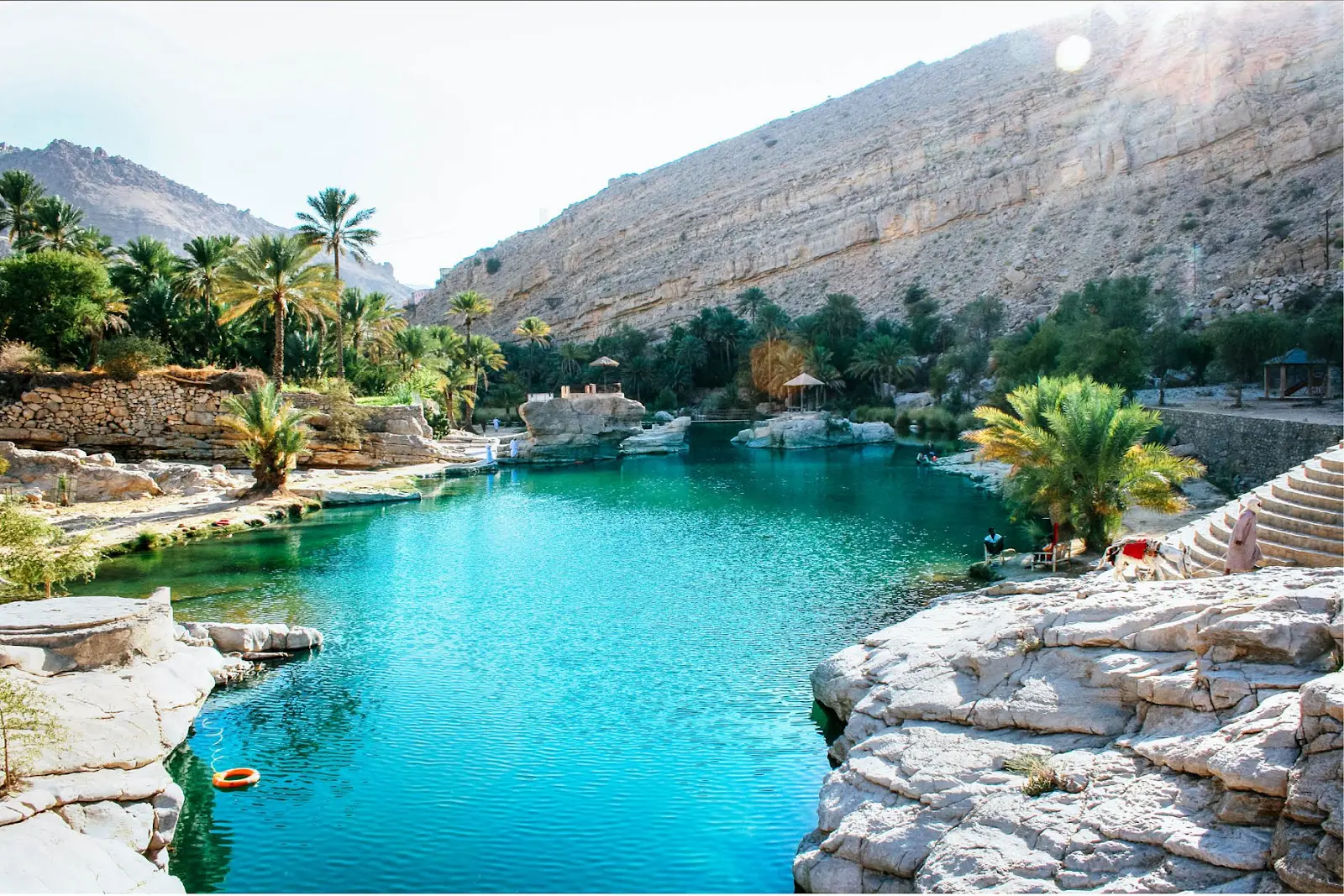
Wadi Bani Khalid
In addition to off-roading, Wadi Bani Khalid is also a prime location for hiking enthusiasts. The wadi features a variety of trails that wind through the mountains and alongside streams that lead to clear, deep natural pools and waterfalls. Hikers can explore the diverse flora and fauna as they trek through this untouched part of Oman. The trails vary in difficulty, providing options for leisurely walks as well as more strenuous hikes that climb to higher elevations for panoramic views of the area.
While Wadi Bani Khalid is an exceptional destination on its own, it is also accessible for day trips from major cities like Dubai. A drive from Dubai to Oman brings visitors through a change of scenery from the bustling cityscape to the serene and stark beauty of the desert, culminating in the unique experience that Wadi Bani Khalid offers. The journey itself is part of the adventure, with the transition between countries highlighting the vast differences in landscape and culture within just a few hours’ drive.
Wadi Bani Khalid stands out as a must-visit for those who are keen on mixing their love for nature with the thrill of adventure sports. The area’s natural beauty is matched by the quality and excitement of the activities available. Off-roading and hiking here are not just about physical exertion; they are about connecting with nature, testing one’s limits, and most importantly, enjoying a day filled with adventure and stunning scenery.
Heritage and History in Bahla
Bahla, an ancient town located in the Sultanate of Oman, offers a profound connection to the past through its historical significance and cultural heritage. This town is distinguished not only by its centuries-old pottery crafts but also by the Bahla Fort, a remarkable edifice that has earned recognition as a UNESCO World Heritage site. The allure of Bahla as a destination extends beyond its immediate geography, making it a compelling choice for day trips from nearby regions such as Dubai.
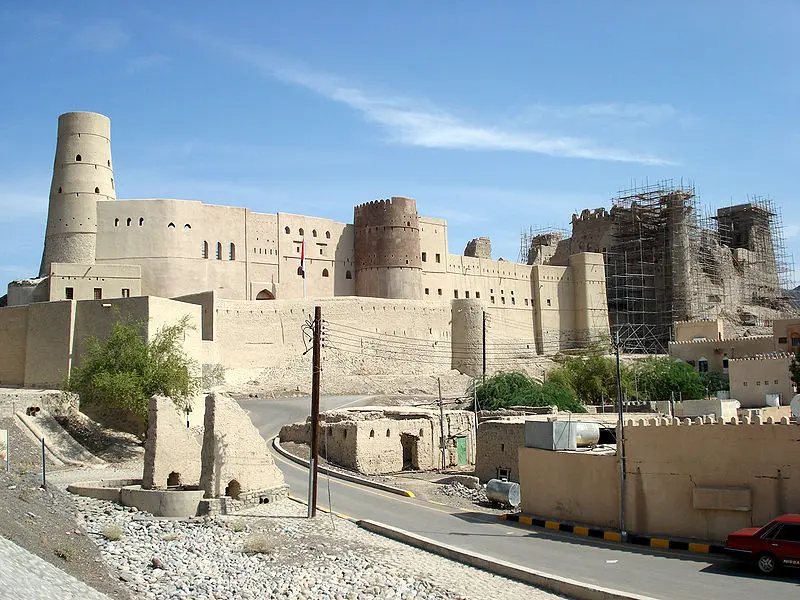
Bahla
The historical roots of Bahla are deeply intertwined with the indigenous traditions and the natural resources of the region. Renowned for its pottery, the town has been a center of ceramic production for many centuries. The unique clay found in the area, combined with traditional methods passed down through generations, has made Bahla pottery highly sought after both locally and internationally. The artistry displayed in these ceramics speaks volumes about the town’s dedication to preserving its cultural identity amidst a rapidly modernizing world.
Beyond its pottery, Bahla is perhaps best known for the Bahla Fort. This imposing structure is one of the oldest and largest forts in Oman and represents a significant chapter in the Arabian Peninsula’s Islamic architecture. The fort’s massive walls and towers, constructed from traditional mud-brick, stand as a testament to the ingenuity and strength of the people who built it over a period that spans several centuries. The fort’s architecture not only provided defense against invaders but also demonstrated the sophisticated urban planning and architectural skills of its constructors.
Bahla Fort’s historical importance is underscored by its designation as a UNESCO World Heritage site. This recognition came after extensive restoration works that highlighted its cultural and architectural significance. The fort is a crucial part of the historical fabric of the region, embodying the Islamic principles and styles that influenced much of the architecture in Oman and the surrounding areas.
For visitors coming from places such as Dubai, Bahla offers a distinct contrast to the modern skyscrapers and bustling city life. A day trip to Bahla allows travelers to delve into the tranquil pace of traditional Omani life. The journey from Dubai to Oman not only brings into relief the physical landscapes but also the shifts in cultural and historical contexts. As travelers cross the border from the United Arab Emirates into Oman, they move from the contemporary allure of Dubai to the historical charm of Bahla.
Exploring Bahla provides an educational journey into the history of the region. The town’s attractions include not only Bahla Fort but also other historical sites like ancient mosques and the remnants of old walls that once protected the town from invaders. Each of these sites contributes to a comprehensive understanding of the historical and cultural evolution of this part of Oman.
Mountain Safari in Jebel Akhdar
Jebel Akhdar, part of the Al Hajar Mountains range in Oman, offers an extraordinary escape into nature with its mountain safaris. This region, translating to “The Green Mountain” in Arabic, lives up to its name with lush terraces and a cooler climate that starkly contrasts the arid surroundings. A visit here is not just about relishing panoramic views but also exploring the rich cultural heritage embedded within its traditional villages.
For adventure seekers and nature enthusiasts, Jebel Akhdar presents an ideal setting for a mountain safari. The terrain here varies from gentle slopes to rugged cliffs, all covered with a diverse range of flora and fauna adapted to the high altitude. The area is renowned for its fruit orchards, where pomegranates, apricots, and roses bloom, depending on the season. These orchards not only add to the visual appeal of the region but also play a crucial role in the local economy and culture, with the rose water distillation process being a unique aspect of local agriculture.
The safari experience in Jebel Akhdar can be enhanced by engaging with the local communities. The villages scattered across the mountainside showcase traditional Omani architecture, with houses built from stone and mud, and are a testament to the ingenuity of ancient construction techniques that blend seamlessly into the natural landscape. Visitors often get the opportunity to interact with the villagers, gaining insights into their daily lives and traditional practices such as weaving and pottery.
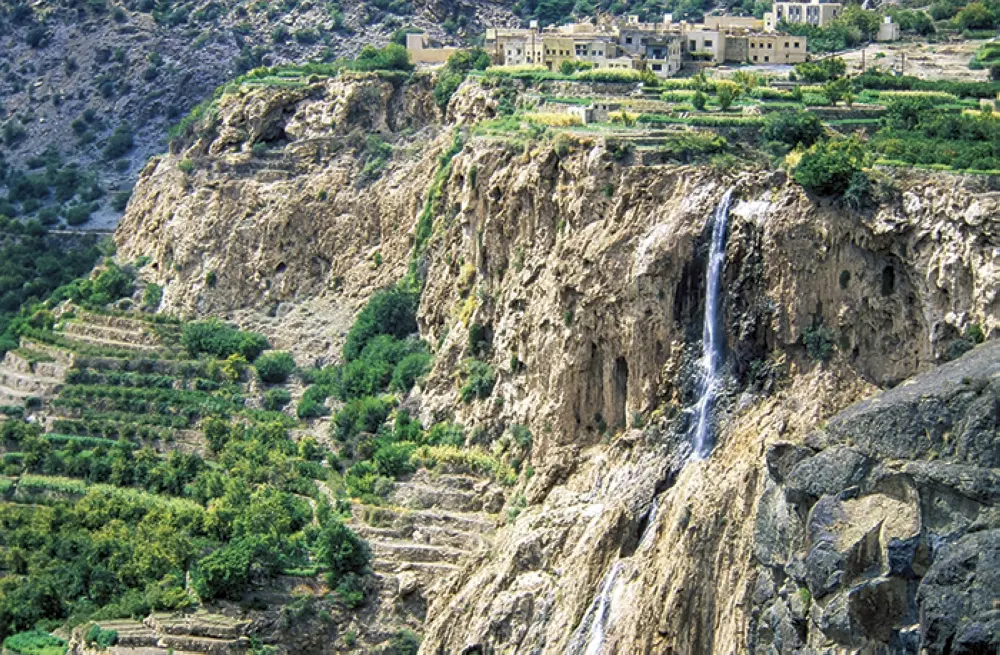
Jebel Akhdar
Apart from cultural immersion, Jebel Akhdar offers plenty of opportunities for outdoor activities. Hiking trails wind through the mountains, some leading to serene spots ideal for picnics or meditation. More challenging routes take adventurers past steep gorges and towering peaks, offering breathtaking views of the landscape below. The cooler climate makes Jebel Akhdar particularly suitable for trekking, especially when the rest of the region experiences high temperatures.
Jebel Akhdar is not just a daytime destination. The clear skies free from light pollution offer an unmatched opportunity for stargazing. Nighttime safaris are a magical experience, with the silence of the mountains only broken by the occasional call of nocturnal animals. The crisp mountain air and the vastness of the starlit sky create a profound sense of peace and isolation from the hustle and bustle of city life.
Conclusion
A day trip from Dubai to Oman offers a splendid opportunity to immerse oneself in a fusion of awe-inspiring landscapes, rich history, and cultural diversity. This venture beyond the bustling cityscapes of Dubai into the serene and starkly contrasting vistas of Oman can be an enriching experience, inviting travelers to explore a realm where modernity meets tradition in the heart of the Arabian Peninsula.
The journey typically starts with a drive through the Hajar Mountains, where the rugged terrains offer a dramatic shift from Dubai’s architectural marvels. The mountains, with their jagged peaks and sparse vegetation, set a vivid backdrop as one crosses into Oman. This natural barrier between the two countries is not only a geographic highlight but also a journey through time, showcasing the ancient earth crusts and offering panoramic views that are both mesmerizing and photogenic.
Upon entering Oman, the city of Muscat awaits with its splendid blend of old and new. Unlike the towering skyscrapers of Dubai, Muscat’s charm lies in its low-rise architecture, which adheres to traditional aesthetic values and cultural heritage. The city is home to beautifully crafted mosques, bustling souks, and museums that narrate the sultanate’s rich maritime history and cultural heritage. A visit to the Sultan Qaboos Grand Mosque, with its massive crystal chandelier and sprawling prayer carpet, highlights the intricate Islamic architecture and offers a serene environment for reflection and admiration.
Further enriching the day trip are the coastal routes along the Gulf of Oman, where one can indulge in the scenic beauty of turquoise waters juxtaposed against stark, arid mountains. The beaches near Muscat offer a tranquil retreat from the desert heat, with opportunities for snorkeling and dolphin watching, providing a glimpse into the marine biodiversity of the region. The clear waters and vibrant marine life form a stark contrast to the desert landscapes, enriching the sensory experience of the traveler.
Food also plays a significant role in the day’s journey, with Omani cuisine offering a delightful array of flavors that reflect the country’s trading history and geographical diversity. From the aromatic and spiced dishes such as shuwa, a slow-cooked marinated lamb, to the fresh seafood along the coast, every meal is an opportunity to savor traditional cooking that has been passed down through generations.
Ending a day trip from Dubai to Oman, one carries back not just memories but a profound appreciation of the region’s natural beauty, cultural richness, and historical depth. Each element of the trip—from the dramatic mountain drives and peaceful beach stops to the cultural explorations in Muscat—contributes to a holistic travel experience. This journey exemplifies how proximity can bring contrasting experiences, making a day trip to Oman not just a passage through landscapes but a journey through the essence of Arabian heritage and hospitality.



